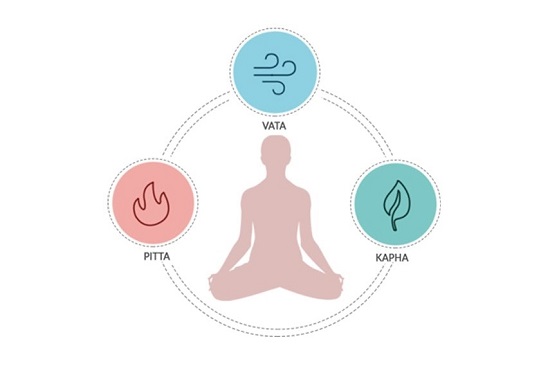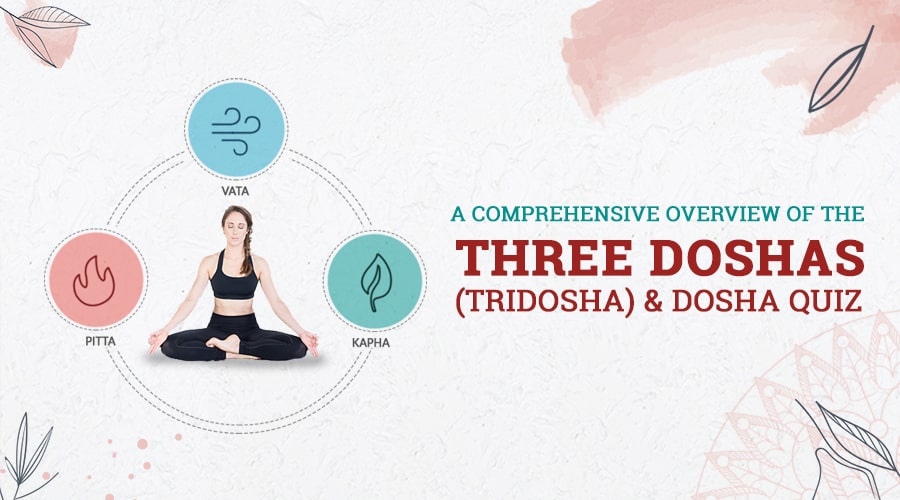A Comprehensive Overview of the Three Doshas (Tridosha) & Dosha Quiz
Whenever you interest yourself in Ayurveda you will learn about the Tridosha, the term Tridosha is can be split in ‘tri’ which means "three", and ‘dosha’ which means “fault”. In this article you will find a video to understand the three doshas: In a healthy body, all elements must renew on a regular basis. However, when an element starts to accumulate and rot in the body, it is called a dosha. Now, everybody depending on its constitution has a tendency to accumulate a certain element.
Whenever there is an accumulation of an element in the body tissues, the body wastes, organs and channels are getting disturbed and this results in physical and mental disease. A dosha, therefore, affects bodily functions and body properties.
The three doshas are:
- Vata – dosha of air and space element
- Pitta – dosha of the fire element
- Kapha – dosha of water and earth element
Each Dosha has five subtypes
VATA | PITTA | KAPHA |
|---|---|---|
1. Prana | 1. Pachaka | 1. Kledaka |
2. Udana | 2. Ranjaka | 2. Bodhaka |
3. Vyana | 3. Bhrajaka | 3. Avalambaka |
4. Samana | 4. Sadhaka | 4. Shleshaka |
5. Apana | 5. Alochaka | 5. Tarpaka |
In each subtype, there is a predominance of one of the five primordial elements.
KAPHA DOSHA
Kapha dosha is made up of earth and water. It is responsible for all lubrication and structure in the body.
Primal Properties of Kapha
Kapha is essential for union, stability, softness, and strength.
- Oily
- Cold
- Heavy
- Slow
- Slimy
- Sticky
- Stable
Common functions of Kapha
- Kapha gives stability & protection to the joints.
- Kapha strengthens the bodily tissues.
- Kapha helps to heal and regenerate the body.
- Kapha gives mental stability and reduces the irritation of mind and intellect.
VATA DOSHA
Vata is the dosha is composed of air and ether. Vata energy is responsible for the movement in the body, nervous activity and the process of excretion.
Primary Properties of Vata
- Dry
- Light
- Cold
- Rough
- Subtle
Common functions of Vata
- Vata dosha gives stimulation to the mind for its normal functioning and controls its activities.
- Vata dosha stimulates sensory and motor organs and mind.
- Vata is also responsible for different sounds produced in the body e.g. heart sounds, respiratory sound, abdominal peristalsis sound, etc.
- Constitution or root cause of sound and touch is Vata dosha. For the perception of sound and touch, Vata is necessary.
- The main composition of auditory senses and touch sense is from Vata.
- The movements required for throwing waste out of the body are done by Vata. For example, Vata does the function of excursion of urine, stool, and sweat.

Discover your Ayurvedic constitution (dosha-dominance) with our free self-assessment.
Fill out our specially curated assessment to discover your dosha balance.
PITTA DOSHA
Pitta is composed of fire and water.
- Primary Properties of Pitta-dosha
- Hot
- Sharp
- Light
- Moist
- Oily
- Shining
- Fluid
- Sour
- Intense
Common functions of Pitta dosha
- Digestion and metabolism: All the processes involving digestion and metabolism from the digestive tract to the cellular level are due to pitta.
- Heat: Generation and regulation of heat in the body.
- Vision: Creating a vision is the function of pitta.
- Hunger: Hunger sensation develops due to the process of metabolism; therefore it is a function of Pitta.
- Thirst: The sensation of thirst is created due to the Pitta activity of generating heat.
- Taste: This is a good indicator of the normal digestion process. When Agni digests the food properly, all the internal systems become clean which develops a good taste sensation on the tongue.
- Luster: Pitta gives shine and luster to the skin and hair.
- Intellect: Pitta is responsible for good intellect.
- Courage: Pitta gives courage, aggression and dare.

